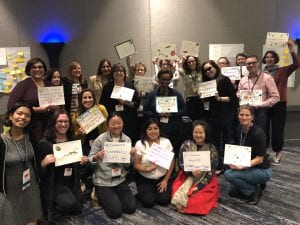Education leaders are increasingly turning to design thinking as a method for re-envisioning their work and reform practices and for tackling the knottiest challenges on their campuses. Career Ladders Project is building a bridge from the broader conversations to the community college context.
First, some definitions. In general, design thinking refers to a process for human-centered, creative problem-solving that asks organizations and their leaders to focus on the end users of their products or services. In the context of education, design thinking refers to using a structured framework to focus on students, identify challenges, gather information, generate potential solutions, and refine and test them.
What CLP has done is tailor the approach for California community colleges to use it as they grapple with Guided Pathways redesign. In two workshops at the Strengthening Student Success Conference in early October, Sia Smith-Miyazaki, a senior program association at CLP, and Jessica Hurless, an associate communications professor at Skyline College, led practitioners to develop hacks to their work and design processes with the Guided Pathways framework specifically in mind.
Here’s a presentation that Sia and Jessica offered on design thinking at SSSC.
“Design thinking starts with defining who the user is and what ultimately is their challenge in using your product or process,” Sia explained at SSSC.
Using composite quotes representative of how Guided Pathways steering committee members characterize their processes, she and Jessica led conference participants through rapidly iterating a wide variety of solutions to roadblocks. The change in participants’ energy — and expectations — was clear as they addressed communications, meeting routines, meeting outcomes, and more.
 Here is an open-source “bootleg” document constantly being updated by associates of Stanford University’s design school, which offers still more tools for applying design thinking (that colleges could modify for use in Guided Pathways redesign).
Here is an open-source “bootleg” document constantly being updated by associates of Stanford University’s design school, which offers still more tools for applying design thinking (that colleges could modify for use in Guided Pathways redesign).